Human Orbital Spaceflights
![]()
International Flight No. 176STS-71Atlantis (14)69th Space Shuttle missionUSA |
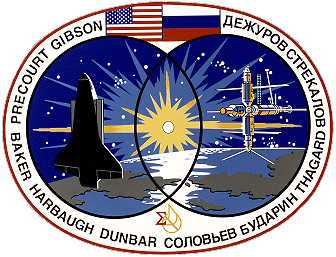 |
 |
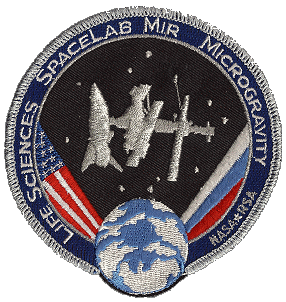 |
||
![]()
Launch, orbit and landing data
walkout photo |
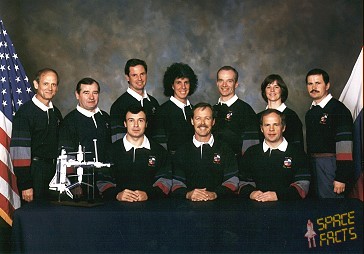 |
||||||||||||||||||||||||||||||||
alternative crew photo |
Crew
| No. | Surname | Given names | Position | Flight No. | Duration | Orbits | |
| 1 | Gibson | Robert Lee "Hoot" | CDR | 5 | 9d 19h 22m 15s | 153 | |
| 2 | Precourt | Charles Joseph | PLT | 2 | 9d 19h 22m 15s | 153 | |
| 3 | Baker | Ellen Louise Shulman | MS-1, EV-2, PLC | 3 | 9d 19h 22m 15s | 153 | |
| 4 | Harbaugh | Gregory Jordan | MS-2, EV-1, FE | 3 | 9d 19h 22m 15s | 153 | |
| 5 | Dunbar | Bonnie Jeanne | MS-3 | 4 | 9d 19h 22m 15s | 153 | |
| 6 | Soloviyov | Anatoli Yakovlevich | Mir-19 K | 4 | 75d 11h 20m 21s | 1194 | |
| 7 | Budarin | Nikolai Mikhailovich | Mir-19 FE | 1 | 75d 11h 20m 21s | 1194 |
Crew seating arrangement
|
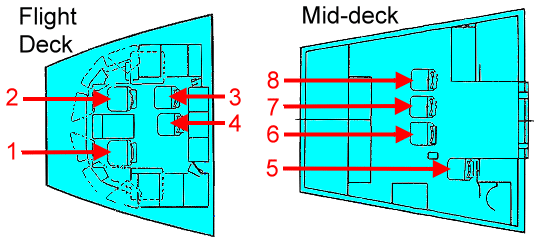 |
|
||||||||||||||||||||||||||||||||||||
Backup Crew
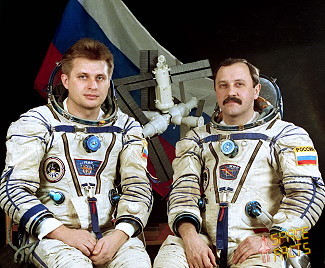
|
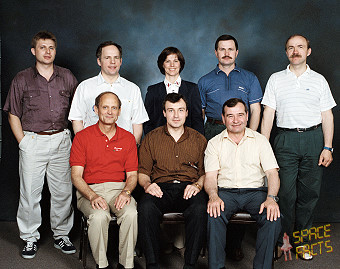
|
|||||||||||||||
Hardware
| Orbiter : | OV-104 (14.) |
| SSME (1 / 2 / 3): | 2028 (10.) / 2034 (6.) / 2032 (3.) |
| SRB: | BI-072 / RSRM 45 |
| ET: | ET-70 (LWT-63) |
| OMS Pod: | Left Pod 03 (18.) / Right Pod 04 (14.) |
| FWD RCS Pod: | FRC 4 (14.) |
| RMS: | - |
| EMU: | EMU No. 2038 (PLSS No. 1008) / EMU No. 2035 (PLSS No. 1015) |
Flight
|
Launch from Cape Canaveral (KSC) and
landing on Cape Canaveral (KSC), Runway 15. The primary objectives of this flight were to rendezvous and perform the first docking between the Space Shuttle and the Russian space station Mir on June 29, 1995. In the first U.S.-Soviet docking in twenty years, Atlantis delivered a relief crew of two cosmonauts Anatoli Soloviyov and Nikolai Budarin to Mir. Other prime objectives were on-orbit joint United States of America-Russian life sciences investigations aboard SPACELAB/Mir, logistical resupply of the Mir and returning of US astronaut Norman Thagard. Secondary objectives included filming with the IMAX camera and the Shuttle Amateur Radio Experiment-II (SAREX-II) experiment. STS-71 marked a number of historic firsts in human spaceflight history: the 100th U.S. human space launch conducted from the Cape; first U.S. Space Shuttle-Russian space station docking and joint on-orbit operations; largest spacecraft ever in orbit; and the first on-orbit changeout of a Shuttle crew. Mir was the first space station designed for expansion. The 20.4-ton Core Module, Mir's first building block, was launched in February 1986. The Core Module provided basic services (living quarters, life support, power) and scientific research capabilities. It had two axial docking ports, fore and aft, for Soyuz TM manned transports and automated Progress M supply ships, plus four radial berthing ports for expansion modules. Until STS-71, the Russians had added three expansion modules to the Mir core: Kvant: Berthed at the core module's aft axial port in 1987, the module weighed 11 tons and carries telescopes and equipment for attitude control and life support. Kvant2: Berthed at a radial port since 1989, the module weighed 19.6 tons and carried an EVA airlock, two solar arrays, and life support equipment. Kristall: Berthed opposite Kvant2 in 1990, Kristall weighed 19.6 tons and carries two stowable solar arrays, science and technology equipment, and a docking port equipped with a special androgynous docking mechanism designed to receive heavy (up to about 100 tons) spacecraft equipped with the same kind of docking unit. The androgynous unit was originally developed for the Russian Buran Shuttle program. The androgynous unit was tested with the Russian Spacecraft Soyuz TM-16. The Russians will move Kristall to a different radial Mir port to make room for the new Spektr module, which was launched on May 20, 1995. Atlantis used the androgynous docking unit on Kristall for the first Shuttle-Mir docking in June 1995. STS-71's rendezvous and docking with the Russian space station Mir actually began with the precisely timed launch of Atlantis on a course for the station. Over the next two days, periodic small engine firings gradually brought Atlantis to a point eight nautical miles (14.8 km) behind Mir. At that time, on the third day of the flight, a Terminal Phase Initiation (TI) burn was fired, and the final phase of the rendezvous began. Atlantis closed the final eight nautical miles (14.8 km) to Mir during the next 90-minute orbit. As Atlantis moved in, the Shuttle's rendezvous radar system began tracking Mir and provided range and closing rate information to the Shuttle crew. As Atlantis neared Mir, the Trajectory Control Sensor, a laser ranging device mounted in the payload bay, supplemented the Shuttle's onboard navigation information by supplying additional data on the range and closing rate. Docking occurred at 13:00:16 UTC, June 29, 1995, using R-Bar or Earth radius vector approach, with Atlantis closing in on Mir from directly below. R-bar approach allows natural forces to brake the orbiter's approach more than would occur along standard approach directly in front of the space station; also, an R-bar approach minimizes the number of orbiter jet firings needed for approach. The manual phase of the docking began with Atlantis about a half-mile (900 m) below Mir, with Robert Gibson at the controls on aft flight deck. Stationkeeping was performed when the orbiter was about 75 meters (246 ft) from Mir, pending approval from Russian and U.S. flight directors to proceed. Robert Gibson then maneuvered the orbiter to a point about 10 meters (33 ft) from Mir before beginning the final approach to station. Closing rate was close to the targeted 0.1 foot per second (30 mm/s), being approximately 0.107 foot per second (33 mm/s) at contact. Interface contact was nearly flawless: less than 25 millimeters (0.98 in) lateral misalignment and an angular misalignment of less than 0.5 degrees per axis. Docking occurred about 216 nautical miles (400 kilometers (250 mi)) above Lake Baikal region of the Russian Federation. Docking began when the orbiter was maneuvered to bring the interfaces of the active docking mechanism in contact with Mir's passive mechanism. At this point, the maximum allowable axial rate of approach of the two vehicles was 0.2 foot (6 centimeters) per second. Minor misalignments of the two mechanisms of up to eight inches (20.3 centimeters) and five degrees were corrected as the orbiter interface was displaced and rotated so the capture ring could latch onto the opposing androgynous interface ring. This rotation was produced by the relative velocity of the two vehicles. Soft latching occurred when the capture ring alignment was complete and the interfaces were aligned. Each of the petals on Atlantis' APAS was equipped with two capture latches. The capture latch assemblies, which operated independently, grapple body mounts on the Mir APAS. Five seconds after capture, dampers designed to reduce relative vehicle motion were activated for 30 seconds. Before the dampers were activated, a load-limiting clutch prevents either vehicle from being overloaded. The dampers were deactivated to allow the dampers to align the vehicles. After the relative motion of the two vehicles had subsided, the retraction phase of the docking process then began. During this phase, the latched capture ring and passive vehicle were pulled into the orbiter mechanism. The five engaged fixators made the capture ring rigid and prevent relative vehicle misalignments from accumulating during retraction. Structural latching occurred at the completion of the capture ring retraction process. Twelve active structural latches located at the structural interface are grouped into two separate activated gangs of six latches each. A passive, immobile hook is located next to each active latch. The Mir mechanism also had these latches and hooks. In the process of structurally latching the orbiter and Mir, latch actuator motors deployed the orbiter's active latches, which hooked onto Mir's passive hooks. The actuator drives the first hook directly, and a cable transmitted power to the remaining five slave hooks. The hooks were driven beyond the point where the hook was overcenter. The overcenter hooks carried the sealing load, rather than the cables. Mir's active latches could also be used to hook onto the orbiter's passive hooks as a backup procedure. The entire docking process was completed in less than one hour. The final portion of the process, after capture, took approximately 15 minutes. Atlantis and Mir were linked by an orbiter docking system (ODS). The $95.2-million orbiter docking system consisted of an external airlock, a supporting truss structure, a docking base, avionics required to operate the system, and a 632-pound (286.7 kg) Russian-built docking mechanism, called the androgynous peripheral assembly system (APAS), which was mounted on top of the airlock and docking base. Atlantis received extensive wiring changes to accommodate the new system, which measured nearly 15 feet (4.57 meters) wide, 6-½ feet (1.98 meter) long, and 13-½ feet (4.11 meters) high and weighed more than 3,500 pounds (1,587 kg). It was installed near the forward end of the orbiter's payload bay and was connected by short tunnels to the existing airlock inside the orbiter's pressurized crew cabin and the pressurized Spacelab module, which was aft of the airlock in the payload bay. The ODS worked flawlessly during the docking sequence. The APAS was a hybrid version of the docking system the Russians used in 1975 for the Apollo-Soyuz Test Project. It differed from its predecessor in several key respects. First, it was much more compact, with an overall external diameter of 60 inches (152 centimeters) compared to 80 inches (203 centimeters) on ASTP, although the inner egress tunnel diameter remained approximately the same. Second, the APAS docking mechanism had 12 structural latches, compared to eight on the ASTP. Third, the APAS guide ring and its extend/retract mechanism were packaged inside the egress tunnel rather than being outside of the mechanism as they were on ASTP. Finally, the three guide petals on the APAS pointed inboard rather than outboard. Both Atlantis and Mir were equipped with an APAS, which consisted of a three-petal androgynous capture ring mounted on six interconnected ball screw shock absorbers, which operated like a sophisticated car suspension system. The absorbers arrested the relative motion of the two vehicles and prevented them from colliding. When linked, Atlantis and Mir formed the largest spacecraft ever in orbit, with a total mass of about 225 metric tons (almost one-half million pounds), orbiting some 218 nautical miles (404 kilometers (251 mi)) above the Earth. After hatches on each side opened, STS-71 crew passed into Mir for a welcoming ceremony. With the Russian and U.S. flags as a backdrop, the STS-71 and Mir crews exchanged gifts on flight day four in the Shuttle's Spacelab module. Gifts included a halved pewter medallion bearing a relief image of a docked Shuttle and Mir space station; the two halves were joined during the ceremony. A 1/200th-scale model of the Shuttle and the Mir also was joined. These gifts were presented to the U.S. and Russian Heads of State and the leaders of the two space agencies after the mission. For five days, about 100 hours in total, joint U.S.-Russian operations were conducted, including biomedical investigations, and transfer of equipment to and from Mir. Fifteen separate biomedical and scientific investigations were conducted, using the Spacelab module installed in the aft portion of Atlantis's payload bay, and covering seven different disciplines: cardiovascular and pulmonary functions; human metabolism; neuroscience; hygiene, sanitation and radiation; behavioral performance and biology; fundamental biology; and microgravity research. The Mir-18 crew served as test subjects for investigations. Three Mir-18 crew members also carried out an intensive program of exercise and other measures to prepare for re-entry into gravity environment after more than three months in space. Numerous medical samples as well as disks and cassettes were transferred to Atlantis from Mir, including more than 100 urine and saliva samples, about 30 blood samples, 20 surface samples, 12 air samples, several water samples and numerous breath samples taken from Mir-18 crew members. Also moved was a broken Salyut 5 computer. Transferred to Mir were more than 450 kilograms (990 lb) of water generated by the orbiter for waste system flushing and electrolysis; specially designed spacewalking tools for use by the Mir-19 crew during a spacewalk to repair a jammed solar array on the Spektr module; and transfer of oxygen and nitrogen from Shuttle's environmental control system to raise air pressure on the station, to improve Mir's consumables margin Joint scientific investigations by the two premier spacefaring nations continued with the flight of STS-71, the Spacelab-Mir mission, providing more knowledge about the human body and the microgravity environment. Research in seven different medical and scientific disciplines begun during Mir-18 was concluded on STS-71. Of the 28 experiments being conducted as part of the joint United States-Russian cooperative effort, 15 was performed as part of the STS-71 mission. The metabolic research on STS-71 included studies of the cardiovascular and pulmonary systems; neurosensory research; hygiene, sanitation, and radiation research; behavior and performance research; fundamental biology research; and microgravity research. Deconditioning of the cardiovascular and pulmonary system, with the occurrence of orthostatic intolerance (or lightheadedness upon standing) observed in returning crew members of long duration spaceflight is of primary interest to researchers. Researchers measured changes in blood volume during flight and the pooling of blood in the legs and abdomen upon reentry. Investigations in neurosensory research begun during Mir-18 focused on the mixed messages the body receives when the brain integrates nerve impulses from the eyes, inner ear, muscles and joints. The brain can no longer rely on gravity as a constant in determining body position and orientation. Two of these studies seek to enhance our understanding of how humans adapt to spaceflight and readapt to Earth's environment. Two investigations in hygiene, sanitation, and radiation research looked at the radiation environment experienced during an extended stay in space, and two others looked at the presence of microbes or trace chemicals found in the air and water consumed by the astronauts. Data from tests to study the long-term effects of microgravity on muscle coordination and mental acuity, collected during more than three months on Mir-18, were returned to Earth aboard Atlantis. A Russian spacecraft control simulator used before, during and after flight, allowed researchers to measure crew member's functional state and manual control performance. STS-71 studied how weightlessness affects embryo development by returning to Earth a set of pre-fertilized quail eggs incubated on board Mir. The incubation process was stopped at various stages of development, and the embryos placed in a fixative solution for later analysis. Improved sensors were carried to orbit by Atlantis to be added to the Mir station greenhouse by the Mir-19 crew. The updated greenhouse then was ready for plant experiments on future NASA-Mir missions. STS-71 carried several hundred protein samples, frozen in a thermos-bottle-like vacuum jacket or dewar, to the Mir space station. After they thaw, the proteins crystallized until the dewar is retrieved by the STS-74 crew in November 1995. The months-long growing time aboard Mir should produce large protein crystals of sufficient size and quality to compare with corresponding crystals grown in Earth-based laboratories. The Mir experiment was used to evaluate the effectiveness of flash-frozen bath and liquid-liquid diffusion techniques for growing protein and virus crystals on long-duration space missions. Experience gained will help shape PCG investigations to be conducted aboard the International Space Station. NASA was using the IMAX film medium to document its space activities and better translate them to the public. This system, developed by IMAX Systems, Corp., Toronto, Canada, uses specially designed 70 mm film cameras and projectors to record and display very high definition, large screen pictures. NASA has flown IMAX camera systems on many Shuttle missions, including the STS-63 Shuttle-Mir rendezvous. NASA continued to use IMAX cameras to collect footage for future productions. Film from previous missions was used to create the productions "The Dream is Alive" and "The Blue Planet". As part of the Shuttle Amateur Radio Experiment (SAREX) students in the United States and other countries had a chance to speak via amateur radio with astronauts aboard the Space Shuttle Endeavour during STS-71. Ground-based amateur radio operators ("hams") were able to contact the Shuttle through automated computer-to-computer amateur (packet) radio links. There also were voice contacts with the general ham community as time permitted. Space Shuttle Pilot Charles Precourt (call sign KB5YSQ) and Mission Specialist Ellen Baker (KB5SIX) talked to students in five schools in the U.S. and Russia using "ham radio". The Mir resident crew was exchanged. Anatoli Soloviyov and Nikolai Budarin became the 19th resident crew. The former 18th resident crew (Vladimir Dezhurov, Gennadi Strekalov, Norman Thagard) returned to Earth with STS-71. After over 100 hours of docked operations, the hatches were closed on both Atlantis and the Mir, and the vestibule in the Shuttle's docking system was depressurized. The initial separation was performed by springs that slightly pushed the Shuttle and the Mir away from each other on a command sent to the docking mechanism from an aft flight deck control panel in Atlantis. Both the Mir and Atlantis were in a mode called "free drift" during the undocking, a mode that has the steering jets of each spacecraft shut off to avoid any inadvertent firings. Once the docking mechanism springs have pushed Atlantis away to a distance of about two feet (60 centimeters) from Mir, the docking devices were clear of one another, and Robert Gibson turned Atlantis' steering jets back on. He immediately lightly fired the Shuttle's jets in the Low-Z mode to begin very slowly moving away from Mir. Atlantis moved away from Mir to a distance of about 400 feet (121.9 meters), where Robert Gibson began a fly around of the station. At that distance, Atlantis circled Mir a little more than one-and-a-half times to gather detailed engineering pictures and video of the space station before firing its jets again to conclude the joint mission. Inflight problems included a glitch with General Purpose Computer 4 (GPC 4), which was declared failed when it did not synchronize with GPC 1; subsequent troubleshooting indicated it was an isolated event, and GPC 4 operated satisfactorily for the remainder of mission. Later Anatoli Soloviyov and Nikolai Budarin performed three EVAs on July 14, 1995 (5h 34m), July 19, 1995 (3h 08m) and July 21, 1995 (5h 50m). The separation of STS-71 was observed from the also separated Soyuz spacecraft. |
Note
|
Anatoli
Soloviyov and Nikolai
Budarin landed on September 11, 1995 at 06:52:40
UTC with Soyuz
TM-21 spacecraft. |
Photos / Graphics
 |
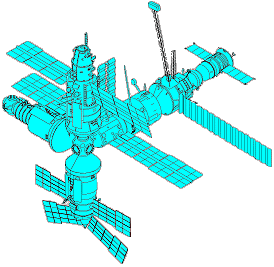 |
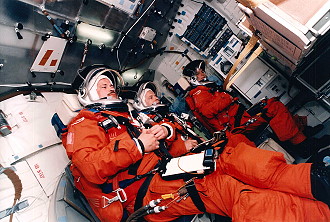 |
 |
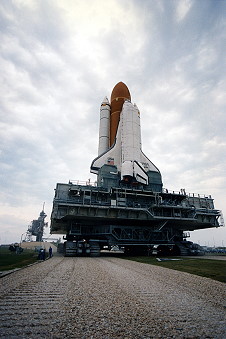 |
 |
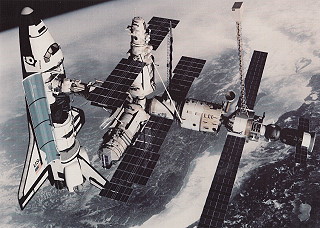 |
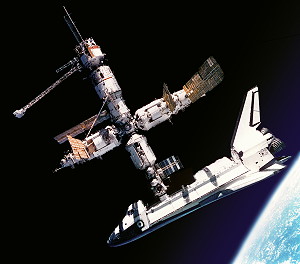 |
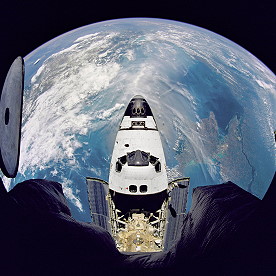 |
 |
 |
 |
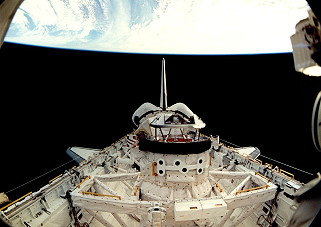 |
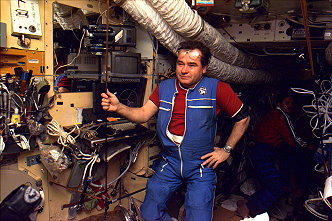 |
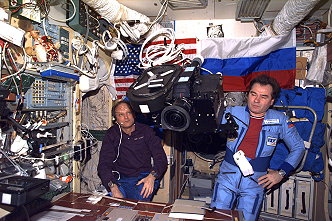 |
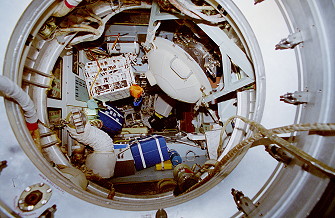 |
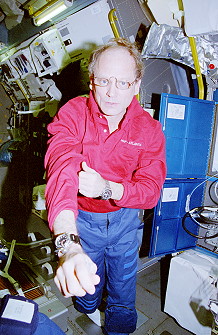 |
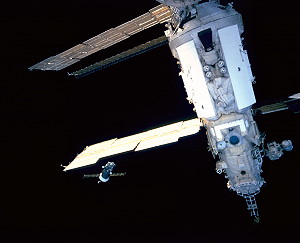 |
 |
| © |  |
Last update on March 27, 2020.  |
 |